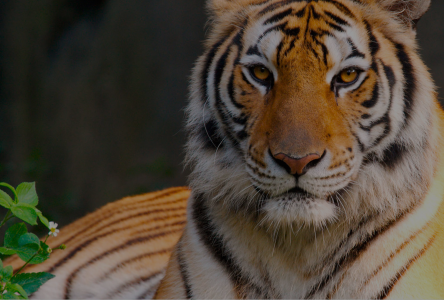
Tiger
King of the forest – Tiger
National Animal of India, Vehicle of Mother Goddess – Tiger, the striped cat is one of the most majestic living being on earth and rightly called the King of the forest. Revered in all the areas where it is found Tiger has always been awed by local population and respected in religion and culture.
In forest regions of India, tribal community from every corner of the country held Tiger on a high esteem. ‘Bagh Deo’ was admired and honoured by locals which is proved by Tiger Temples we find at all places. The orange black striped big cat was also known as ‘Striped Water God’ or revered as our ancestors at places.
Living in forest and saving its tag of the King is not easy. When born a tiger is just a ball of cotton, eyes closed, unaware of outer world. Tigress, after incubation period of 108 – 110 days gives birth to 2 – 4 cubs at a time in a well-hidden and secluded place to save the tiny balls from fury of Jungle. They open their eyes after a few weeks and get the first glimpse of their kingdom. They are kept hidden from the outer world being vulnerable to other carnivores. Tigress ventures out time to time to make a kill and sustain herself as well as her cubs. This is also the time when their home shifts every few days since the cubs are vulnerable and tigress wary of predators keeping a watch to get free meal of defenceless cubs who are only dependent on mothers’ milk.
After a few weeks the cubs start venturing out, in immediate vicinity of their hiding place and scurry back to its safety on any notion of danger. Till they are of few months they are totally dependent on mother’s milk. This is also a time of learning, they try to catch the butterflies, lizards, birds and rats that scurry along at times. Their plays are soft and looking at them playing is feast to eyes. Mother keeps an eye on them with strict instructions not to move out to longer distance from the hiding place. For the cubs their world is their hideout and their mother along with those small insects and birds which they see at times.
They get first taste of meat after a few months. Now they are getting older and start venturing out to a larger area with their mother but are still susceptible to fierce predators. Their plays start getting rougher with each passing week. This is also a time to learn the nuances of jungle life. Mother Tigress is their saviour and teacher for almost 24 to 30 months, before they leave for carving out their own territory. For the mother it gets tiring and may be frustrating at times since the cubs diet grows with age and she has to fend for herself as well as them. Tigers start making their own kill only after they have crossed 24 to 30 months of age. This is the time when tigress knows that the cubs may be able to fend for themselves and slowly starts spending less time with them, giving them freedom to carve out their territory and life.
Tigers diet is solely of other wild animals including Sambahr, Spotted Dear, Langurs, etc., Hunting is not easy and as per research tiger may take up to 20 attempts before a successful kill. After making a kill it may either immediately start eating or may hide its kill at a safe place and come back after a few hours. Tigers have also been known to carry their kill at long distance at times. It needs around 50 – 60 successful hunts per year which can go up to 70 – 80 if tigress has cubs. Hunting is a technique which needs perfection and a slight mistake can give out the hideout of the tiger and an alarm by any animal means all will run to safety. The orange black stripes help the tiger in camouflaging and it has been seen that tigers can sit still behind a small clump of grass undetected for hours.
Tiger has a life span of 12 – 20 years in the wild and has a territory of 20 to 40 Sq Kms with 3 – 4 female living in the area. Size of the territory depends on availability of prey base and landscape of the area. Normally seen alone tigers also have a family life and visit their cubs at times. There was a time when Indian sub-continent boasted of more than 40000 Tigers but with reducing habitat and poaching present wild population in India has come down to around 2000. The biggest setback Tigers faced is ‘shikar’ by the Europeans for whom it is a game and finishing them from any area meant making it easy to exploit the natural resources of that forest. And in modern world they are losing ground to so called developmental projects like Dams, Industries, Roads and like.
Today you can spot Tigers – the majestic big cats in tiger reserves crafted by the Government of India of which the most famous ones are Kanha, Bandhavgarh, Pench, Panna and Ranthambhore in Central India.

